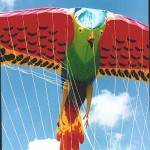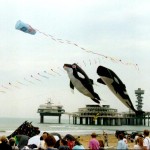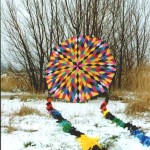I’m Geert Donker Duyvis, born in Delft and still living and flying there. I’ve been a real kiteaholic for years ( in Dutch: vliegeritus). Although my main interest is designing kites which are original and beautiful I’m interested in every aspect of kiteflying, from fighter kites to power kites, and from aerial ballet to aerial photography. I fly them mainly at Scheveningen Beach, parks in Delft, and kite festivals in Holland. Due to lack of time and lack of money (I’ve been a student up till recently) I’ve not been to many kite festivals abroad. I don’t have any professional links with kiteflying–it’s just a hobby–but my education as bachelor of science is sometimes useful.
How it all started:
In 1977 my father bought the book ‘Kites’ by David Pelham, which was just released. The pictures and stories fascinated mainly my older brother Frits. Soon our first kites, two Ace (or Trlby) kites were bought at Vlieger Op, now one of the world’s major kite stores, but back then just started as a very small and very full shop in The Hague. Soon Frits started to build his own kites, classic designs, sometimes in big sizes (3 m Conyne, 6 m Cody, 2.5×2.5 m parafoil). Since I was just 7 at that time, I was mainly watching and running around with small delta kites or fighter kites with tail. During the 80’s, Frits got more and more interested in model planes (he was European champion r.c. gliders, 1994), and he lost interest in kites.
After some paper and tyvek kites I tried to built my first nylon kite in 1983. It was a bright orange Flare and to my surprise it flew very nicely, although it needed a tail. I still own this kite but when I look at it I’m surprised that it flew at all; even the straight stiches look like zigzag lines! Soon my skills improved and after lots of classic designs I started to design my own kites. Now I am the proud owner of about 50 single line kites and 40 stunters, most of which are home built.
Most of my kites are sewn on a Pfaff 90 sewing machine, truly the Harley Davidson of the sewing machine. I still use it for heavy duty jobs. A few years ago I bought a Pfaff 955 dualmatic with double transport system (walking foot). It really helps when stitching multiple layers of fabric.
The pictures:
The waffle is my first own design and is a cross between Tutsomu Hiroi’s multicell box and a Peter Lynn box. It is successfully copied by other kite fliers and pictures of it appeared in several magazines. In 1995 Valerie Govig described it in an article in Kite Lines as, “several Lynn units very compounded in offset positions. The design uses single pieces of cloth woven over the spars. Difficult to describe but very original.”
The dragonkite is based on a Genki kite, the body is inflated through the mouth. The frame is carbon tube 11mm. and 6mm. It was built in 1991 and is a real crowd drawer, wherever I fly it. It flies best in light winds, you can even walk around with it on days without any wind, which makes it even more spectacular.
The killer whale is a softkite, designed in the autumn of 1993 at about the same time as Peter Lynn’s dolphin. These sea creatures first met at the Scheveningen Kite Festival 1994.
The birdkite is a soft kite based on a Peel. All available colors of icarex are used in this 7×5 m. kite. As a stunt kite it is a poor performer; I can just fly a circle at 50 m. lines, but it looks marvelous. The legs move, the feathers on the body move around, and the color of the tail changes due to the light shining through different layers of fabric. The kite was built in 1994 and took 80 m. of icarex, the bridle took more than 1000 m of dyneema, and it took about 300 hours to build. Since it is a very big Peel design, the pull is incredible.
The centipede consists of 20 rokkaku kites 0.8x1m. with triangles of fabric on the connecting lines to represent legs. The head is just a decoration and can be used to attach fireworks for a fire spitting dragon or boxes of confetti for a child-friendly dragon.
The airplane is a very easy flying kite with delta wings. It needs a medium or strong wind, but flies with almost no pull and is stable on a short line. I particularly like it because you can walk around at kite festivals and talk to everyone with the kite flying from your hand.
The octagon is a simple kite, but still a nice way to use small remainders of fabric.
Pictures of the bird kite and the dragon were used on the cover of the Dutch kite magazine ‘Vlieger’ and full descriptions of the waffle kite and the centipede also appeared in ‘Vlieger’.
A few of the scariest moments of my kite life:
Years ago a 3m box kite with heavy wooden dowel broke completely apart in full flight during a wind gust. The remains fell down on the side of a highway. Just a few feet further and it could have caused a major accident. I’m glad that glassfibre and carbon tubes enable us to build lighter and safer kites nowadays.
One day on the flying field I forgot my lines. A friend lent me a line and assured me it was dyneema, estimated breaking strength a few hundred pounds, so I flew my 8 ft Compound Cody on it. It turned out to be a nylon line breaking strength a few dozen pounds, so soon my kite was floating away. Luckily it landed undamaged a few miles away.
A few moments of heaven in my kitelife:
The first time I saw a Cody man lifting system at work — I’ve been in love with Cody kites ever since. One of my first kites was a Cody my brother built for me. I’ve built at least a dozen Cody’s in different sizes in the last twenty years, and one of my most recent kites was a full carbon framed Cody.
The first flight of my dragon, on a summer evening in the middle of nowhere with just enough wind to let it float in the air — I had been dreaming for months how it would look, but the real sight of it against the sun was unbelievable better than I could imagine. That evening really was a fairytale.
And an old classic every kiteflier knows, children passing by and looking up in amazement.
Greetings from Holland,
Geert Donker Duyvis







